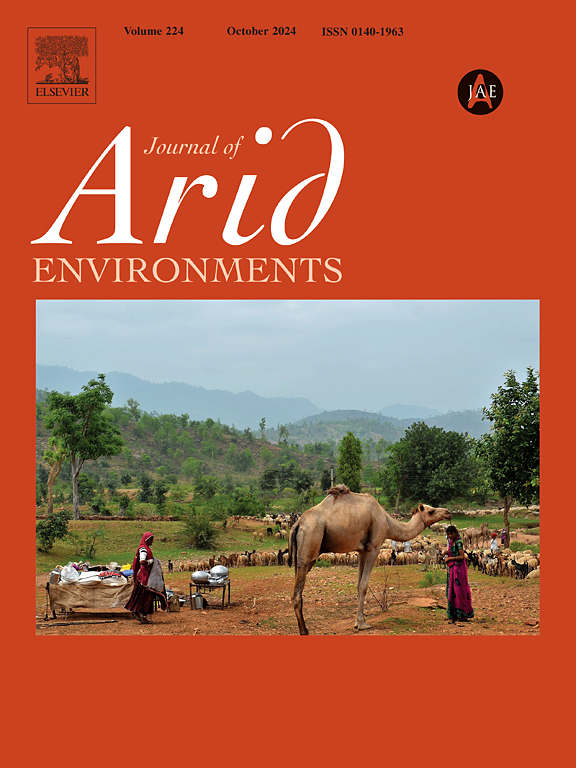迁徙的蒙塔古鹞在塔尔沙漠的停留取决于植被绿度和蚱蜢数量,而不是蝗虫爆发情况
IF 2.6
3区 环境科学与生态学
Q2 ECOLOGY
引用次数: 0
摘要
食物供应是候鸟决定停留或离开停留地的一个重要标准。这取决于停留地的条件。印度次大陆的塔尔沙漠是该地区南部越冬鸟类的主要中途停留地。该沙漠还容易随机爆发沙漠蝗虫,而这些蝗虫的爆发时间往往与候鸟的中途停留时间相吻合。2017年至2022年期间,我们使用PTT和GPS-GSM发射器追踪了9只被标记的蒙塔格鹞(Circus pygargus),以确定沙漠中停歇地的停歇时间是否受迁徙蝗虫或留鸟蚱蜢的影响,以及鸟类采取的策略,如在大范围或多个地点觅食,以确保在停歇期间补充能量。2019 年蝗虫爆发高峰期的平均停留时间为 12 天,而其他年份为 18 天。鸟类并没有刻意追踪蝗虫的发生,无论蝗虫爆发与否,每年都喜欢在相同的地点停留。在停歇地的停歇时间似乎与到达日期、植被绿度(NDVI)有关,并与蝗虫的丰度略有关联。我们的结论是,蝗虫在停歇地的随机出现可能只是为迁徙鹞提供了丰富食物的机会性来源,似乎并不影响它们的停歇时间。相反,它们选择了一种更稳定的策略,即依赖栖息地的蝗虫,这种策略不易受停留地蝗虫丰度和分布的强烈波动的影响。本文章由计算机程序翻译,如有差异,请以英文原文为准。
Stopover by migrant Montagu's Harriers in the Thar Desert is determined by vegetation greenness and grasshopper abundance but not locust outbreaks
Food availability is an important criterion for migrant birds' decision to stay or leave a stopover site. This can vary depending on the conditions at the site. The Thar Desert of the Indian subcontinent is a major stopover area for birds wintering further south in the region. The desert is also prone to stochastic outbreaks of desert locusts that often coincide with the stopover time of migrating birds. Between 2017 and 2022, we tracked nine tagged Montagu's Harriers (Circus pygargus) using PTT and GPS-GSM transmitters to determine if the stopover duration at stopover sites in the desert is influenced by the availability of migratory locusts or resident grasshoppers and the strategies the birds employ, such as, foraging over a wide area or multiple sites to ensure refuelling during stopover. The mean stopover duration during the 2019 peak locust outbreak was 12 days compared to 18 days in other years. Birds did not track locust occurrence deliberately and preferred to stopover at the same sites each year, irrespective of locust outbreaks. The stopover duration at stopover sites appears to be linked to arrival date, vegetation greenness (NDVI) and marginally to grasshopper abundance. We conclude that the stochastic availability of locusts at stopover sites may provide only an opportunistic source of abundant food for migrant harriers and does not seem to affect their stopover duration. Instead, they choose a more stable strategy of relying on resident grasshoppers, less prone to strong fluctuations in abundance and distribution at the stopover sites.
求助全文
通过发布文献求助,成功后即可免费获取论文全文。
去求助
来源期刊

Journal of Arid Environments
环境科学-环境科学
CiteScore
5.70
自引率
3.70%
发文量
144
审稿时长
55 days
期刊介绍:
The Journal of Arid Environments is an international journal publishing original scientific and technical research articles on physical, biological and cultural aspects of arid, semi-arid, and desert environments. As a forum of multi-disciplinary and interdisciplinary dialogue it addresses research on all aspects of arid environments and their past, present and future use.
 求助内容:
求助内容: 应助结果提醒方式:
应助结果提醒方式:


